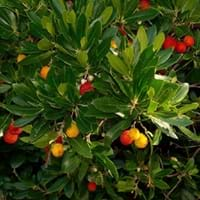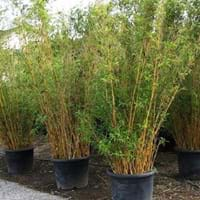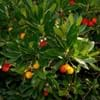Life Span
Perennial
Perennial
Origin
Hybrid origin
China
Types
Not Available
Greenstripe Vivax, Moso, Weavers Bamboo, Oldhamii
Habitat
All sorts of environments
Subtropical climates, Wet Woods
USDA Hardiness Zone
7-9
8-12
Sunset Zone
8, 9, 14, 15, 16, 17, 18, 19, 20, 21, 22, 23, 24
H1, H2, 8, 9, 14, 15, 16, 17, 18, 19, 20, 21, 22, 23, 24
Habit
Twisted/Contorted
Clump-Forming
Minimum Width
Not Available
Flower Color
White
Pale White
Flower Color Modifier
Bicolor
Bicolor
Fruit Color
Red
Not Available
Leaf Color in Spring
Green, Dark Green
Green
Leaf Color in Summer
Dark Green
Light Green
Leaf Color in Fall
Dark Green
Green
Leaf Color in Winter
Dark Green
Green
Plant Season
Spring, Summer, Fall, Winter
Spring, Summer, Fall, Winter
Sunlight
Full Sun, Partial Sun, Partial shade
Full Sun, Partial Sun
Growth Rate
Slow
Very Fast
Type of Soil
Clay, Loam, Sand
Loam, Sand
The pH of Soil
Acidic, Neutral
Acidic, Neutral, Alkaline
Soil Drainage
Well drained
Well drained
Bloom Time
Spring, Late Spring, Fall, Late Fall, Early Winter
Not Available
Tolerances
Drought, Salt
Drought
Where to Plant?
Ground
Container, Ground
How to Plant?
Budding, Seedlings, Stem Cutting
Grafting, Seedlings, Stem Planting, Transplanting
Plant Maintenance
Medium
Medium
Watering Requirements
Allow to dry out slightly between watering, Average Water Needs
Needs watering once a week, Use Mulches to help prevent water loss during hot and windy weather, Water Deeply
In Summer
Lots of watering
Lots of watering
In Spring
Moderate
Moderate
In Winter
Average Water
Average Water
Soil pH
Acidic, Neutral
Acidic, Neutral, Alkaline
Soil Type
Clay, Loam, Sand
Loam, Sand
Soil Drainage Capacity
Well drained
Well drained
Sun Exposure
Full Sun, Partial Sun, Partial shade
Full Sun, Partial Sun, Partial shade
Pruning
Cut leaves after fall, Cut upper 1/3 section when young to enhancegrowth, Remove damaged leaves, Remove dead branches, Remove dead leaves
Do not prune during shooting season, Prune in late summer or fall, Remove damaged leaves
Fertilizers
All-Purpose Liquid Fertilizer, Compost, fertilize in growing season
All-Purpose Liquid Fertilizer
Pests and Diseases
Aphids, Bacteria wilt, Fungal Diseases, Rats, Red blotch
Black sooty mold, Mealybugs, Mosaic viruses, Powdery mildew, pythogens, Stem rot
Plant Tolerance
Dry soil, Salt and Soil Compaction, Shallow soil
Drought
Flower Petal Number
Single
Single
Fragrant Flower
Not Available
No
Fragrant Fruit
Not Available
No
Fragrant Leaf
Not Available
No
Fragrant Bark/Stem
Not Available
No
Foliage Texture
Medium
Coarse
Foliage Sheen
Matte
Matte
Attracts
Birds
Beetles, Bugs, Mites
Allergy
allergic conjunctivitis, Itchy eyes, Respiratory problems
allergic conjunctivitis, Asthma, Rash, Respiratory distress
Aesthetic Uses
Beautification, Hanging Basket, Showy Purposes
Showy Purposes
Beauty Benefits
Beautiful Skin, Good for the Scalp, Moisturizing, Remove blemishes
Not Available
Environmental Uses
Absorbs greenhouse gases, Food for animals, Insect Repellent, Prevent Soil Erosion, Shadow Tree
Agroforestry, Air purification, No fertilizer, pesticides, or herbicides needed
Medicinal Uses
Acne, Dysentry, Nutritive, osteoporosis
Aging, Anti-fungal, Antispasmodic, Digestive disorders, Obesity
Part of Plant Used
Flowers, Fruits, Leaves
Stem, Tree trunks
Other Uses
Animal Feed, Application in Handicrafts, Biomass for fuel, Oil is used for aromatherapy
Economic Purpose, Traditional medicine, Used As Food, Used for woodware, Used in Furniture, Used in paper industry
Used As Indoor Plant
No
No
Used As Outdoor Plant
Yes
Yes
Garden Design
Feature Plant, Mixed Border
Feature Plant, Screening / Wind Break, Tropical
Botanical Name
Arbutus menziesii
BAMBUSA beecheyana
Common Name
Arbutus
Beechey's Bamboo, Clumping Bamboo
In German
Erdbeerbaum
Verklumpung Bambus
In French
arbousier
clumping Bamboo
In Spanish
Arbitus
clumping Bamboo
In Greek
κουμαριά
συσσώρευση μπαμπού
In Portuguese
árbuto
bambu aglutinação
In Polish
mącznik
zbicie bambus
In Latin
arbutus
clumping Bamboo
Phylum
Magnoliophyta
Magnoliophyta
Class
Not Available
Liliopsida
Clade
Angiosperms, Asterids, Eudicots
Angiosperms, Commelinids, Monocots
Tribe
Not Available
Bambuseae
Subfamily
Arbutoideae
Bambusoideae
Number of Species
Not Available
Season and Care of Arbutus and Clumping Bamboo
Season and care of Arbutus and Clumping Bamboo is important to know. While considering everything about Arbutus and Clumping Bamboo Care, growing season is an essential factor. Arbutus season is Spring, Summer, Fall and Winter and Clumping Bamboo season is Spring, Summer, Fall and Winter. The type of soil for Arbutus is Clay, Loam, Sand and for Clumping Bamboo is Loam, Sand while the PH of soil for Arbutus is Acidic, Neutral and for Clumping Bamboo is Acidic, Neutral, Alkaline.
Arbutus and Clumping Bamboo Physical Information
Arbutus and Clumping Bamboo physical information is very important for comparison. Arbutus height is 460.00 cm and width 240.00 cm whereas Clumping Bamboo height is 1,070.00 cm and width Not Available. The color specification of Arbutus and Clumping Bamboo are as follows:
Arbutus flower color: White
Arbutus leaf color: Green and Dark Green
Clumping Bamboo flower color: Pale White
- Clumping Bamboo leaf color: Green
Care of Arbutus and Clumping Bamboo
Care of Arbutus and Clumping Bamboo include pruning, fertilizers, watering etc. Arbutus pruning is done Cut leaves after fall, Cut upper 1/3 section when young to enhancegrowth, Remove damaged leaves, Remove dead branches and Remove dead leaves and Clumping Bamboo pruning is done Do not prune during shooting season, Prune in late summer or fall and Remove damaged leaves. In summer Arbutus needs Lots of watering and in winter, it needs Average Water. Whereas, in summer Clumping Bamboo needs Lots of watering and in winter, it needs Average Water.





